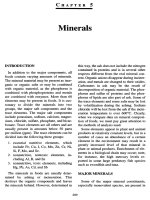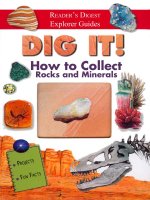Nutrition11 minerals
Bạn đang xem bản rút gọn của tài liệu. Xem và tải ngay bản đầy đủ của tài liệu tại đây (571.05 KB, 80 trang )
Major Minerals
Chapter 11
Major Minerals
• A major mineral is required in the diet and present in
the body in large amounts compared with the trace
minerals.
• Minerals are inorganic elemental atoms or ions.
• Minerals are not changed during digestion or when
the body uses them.
Major Minerals
• Minerals are not destroyed by heat, light, or
alkalinity.
• Some minerals assist enzymes.
• Some minerals have structural roles.
Minerals In the Human Body
Minerals in Foods
• Foods from both plants and animals are sources of
minerals.
• Animal tissues contain minerals in the proportions
that animals need.
Minerals in Foods
• The mineral content of plants can vary dramatically
depending upon the minerals in the soil where the
plant is found.
• The maturity of the vegetable, fruit, or grain can
affect the mineral content.
Mineral Bioavailability
• The GI tract absorbs a much smaller proportion of
minerals than vitamins.
• Once absorbed, excess minerals are difficult for the
body to flush out.
• The body adjusts mineral absorption in relation to
needs.
Mineral Bioavailability
• Some minerals compete for absorption sites.
Megadosing with one mineral can impede
absorption of another.
• High-fiber diets reduce absorption of iron,
calcium, zinc, and magnesium.
• Phytate (a component of whole grains) binds
minerals and carries them out of the intestine
unabsorbed.
• Oxalate (found in spinach and rhubarb) binds
calcium, reducing its absorption.
Mineral Bioavailability
Sodium
• Sodium (Na) is an essential nutrient.
• Sodium is a component of sodium chloride (table
salt).
• Sodium in the diet is essential for normal body
function, but we shouldn’t eat too much salt.
• Major extracellular cation.
Sodium Functions
• Fluid balance. Maintains proper body water
distribution and blood pressure.
• Nerve transmission and muscle function.
• Control’s the body’s acidity.
Sodium Food Sources and
Recommended Intake
•
•
•
•
Limit to 2,300 milligrams / day (DV)
Processed foods contribute the most sodium.
Table salt contributes some.
Sauces, pickled foods, salty meats, cheese, salted
snack foods, bouillon cubes, canned and instant
foods, and seasonings based on salt can all be high
sources.
• The GI tract absorbs nearly all dietary sodium.
• The kidneys excrete excess.
Sources of Dietary Sodium
Hyponatremia
• Hyponatremia – abnormally low sodium
concentrations in the blood due to excessive
excretion of sodium (by the kidenys), prolonged
vomiting, or diarrhea.
• Replacement of water without sodium.
Hyponatremia
• Symptoms of hyponatremia resemble dehydration.
• Treatment involves replacement of fluids and
minerals through liquids and foods or intravenous
solutions if necessary.
Hyponatremia
• Severe hyponatremia causes extracellular fluid to
move into cells, causing them to swell.
• Brain cells swell – headache, confusion, seizures,
coma.
• Cancer, kidney disease, and heart disease can cause
hyponatremia.
Hypernatremia
• Hypernatremia – abnormally high sodium
concentrations in the blood due to increased kidney
retention of sodium or rapid ingestion of large
amounts of salt.
• Hypervolemia – an abnormal increase in the
circulating blood volume.
Hypernatremia
• Hypervolemia leads to edema (swelling) and a rise in
blood pressure.
• A healthy person with normal kidneys and ample
water intake rapidly excretes excess sodium.
Hypernatremia
• Hypernatremia is seen in patients with congestive
heart failure and kidney disease.
• Eating too much sodium over a long period of time
can contribute to hypertension (high blood pressure)
in some people.
• Excess dietary sodium can contribute to osteoporosis
by increasing calcium loss in the urine.
Exercise and Sodium Sensitivity
• A recent study sought to
examine if aerobic exercise
training in older people with
hypertension changes sodium
sensitivity with individuals
switching from sodium
sensitive to sodium resistant.
• The study was validated and
shows that that aerobic
training in older hypertensive
people can alter blood
pressure sensitivity.
ADA Dietary Guidelines for
Americans
• Consume less than 2,300 mg (approximately 1
teaspoon of salt) of sodium per day.
• Choose and prepare foods with little salt. At the same
time, consume potassium-rich foods, such as fruits
and vegetables.
• Key recommendations for Specific Population
Groups: Individuals with hypertension, blacks, and
middle-aged and older adults. Aim to consume no
more than 1,500 mg of sodium per day, and meet the
potassium recommendation (4,700 mg/day) with
food.
Potassium
• Major intracellular cation.
• If people with hypertension eat a diet rich in
potassium containing foods (fruits and vegetables),
their blood pressure often improves.
Potassium Functions
• Muscle contractions
• Transmission of nerve impulses
• Helps regulate blood pressure
Potassium Food Sources and
Recommended Intake
• Fresh vegetables and fruits.
– Especially potatoes, spinach, melons, and
bananas.
• Fresh meat, milk, coffee, and tea also contain some
potassium.
Food Sources of Potassium









